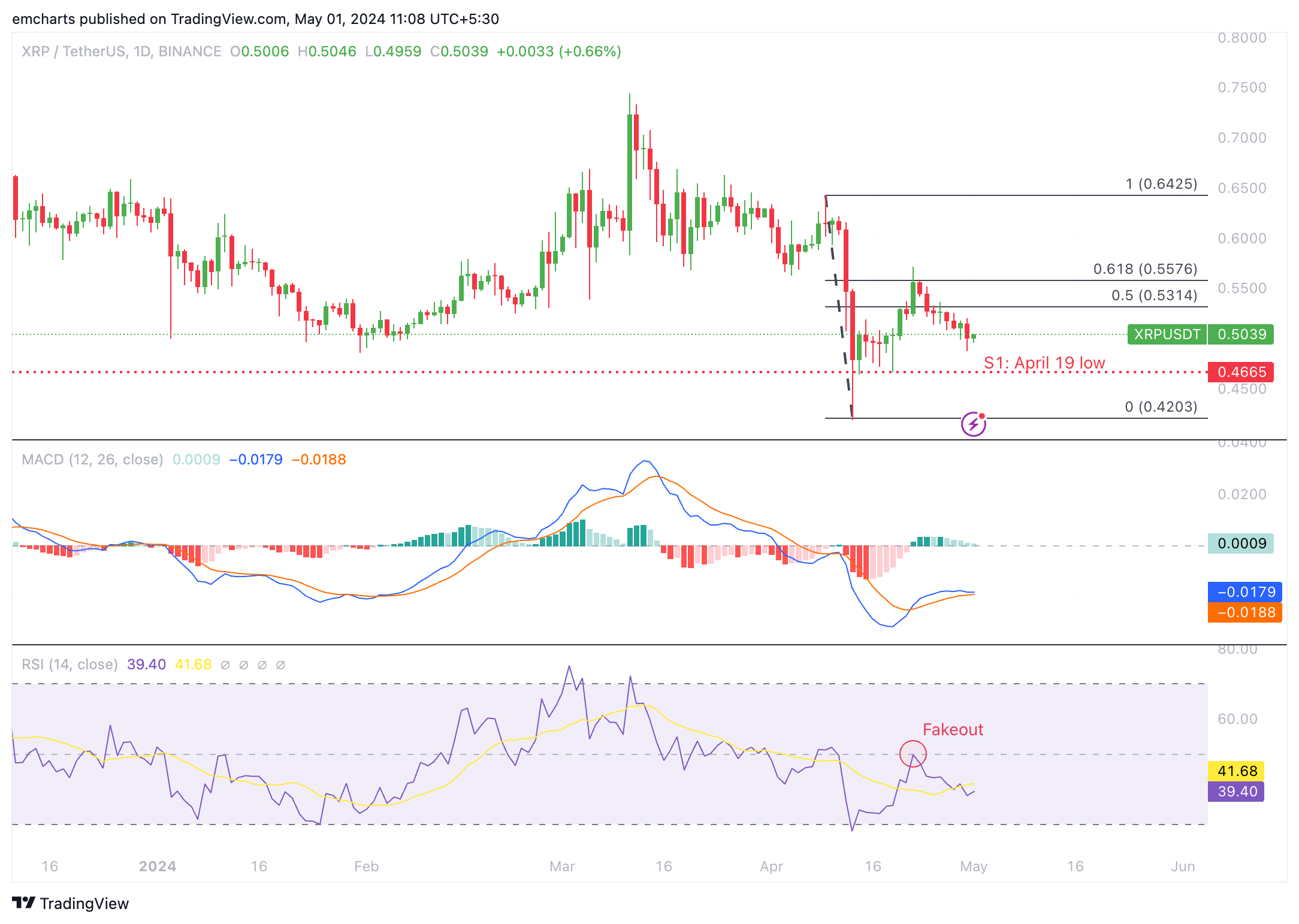Ripple XRP Ledger enters the Japanese market through key partnership, XRP sustains above $0.50
- Ripple announced its partnership with Tokyo-based Hashkey DX to bring XRP Ledger to Japan.
- XRP holders digest the news of Ripple’s foray into Japan, and SEC response from April 29.
- XRP hovers around key support at $0.50, early on Wednesday.
Ripple (XRP) sustained above $0.50, a key support level, on Wednesday. XRP price is down nearly 6% in the past ten days. The altcoin is in a confirmed downward trend, and wiped out all gains since February.
XRP holders are currently digesting the Securities and Exchange Commission (SEC) response filing to Ripple’s motion to strike expert testimony. Ripple announced its partnership with HashKey DX, a Tokyo-based consulting company, to bring XRP Ledger to the Japanese market.
Daily digest market movers: Ripple forays into Japan, XRP Ledger enters market with partnership
- Ripple announced a partnership with Tokyo-based specialized consulting company HashKey DX, on April 30.
- The firm introduced the XRP Ledger powered enterprise solutions to the Japanese market.
- The HashKey Group has over 4,000 registered companies, 23 banks, and 4,300 suppliers for its blockchain-powered supply chain finance solutions.
- XRP Ledger’s enterprise solutions will be offered to Japanese clients through the collaboration between Ripple and SBI Ripple Asia.
- The blockchain solutions will be built on the ledger and Japan’s SBI Group companies will be the first corporation to utilize supply chain finance in the market.
We’re excited to announce a partnership between @Ripple, @HashKeyGroup, and SBI Group ushering in #XRPL-powered solutions, starting with supply chain finance, to Japan's enterprise landscape.
— Ripple (@Ripple) April 30, 2024
Learn more about this innovative partnership: https://t.co/GFUNdu1ci2
- XRP holders are currently digesting the SEC’s response to the legal battle between the cross-border payment remittance firm and the regulator. Find out more about it here.
Technical analysis: XRP hovers around $0.50, extends decline
Ripple extended its decline on Wednesday, hovering around support at $0.50, early on Wednesday. The altcoin has consistently formed lower highs and lower lows since March 11, at a top of $0.7440.
XRP is hovering around key support at $0.50. Relative Strength Index (RSI), a momentum based oscillator, is at 39.40, likely heading towards the oversold zone below 30. RSI attempted to break past the neutral line on April 22, however, it turned out to be a fakeout. RSI is on a downward trend alongside the price, which confirms the decline.
The Moving Average Convergence Divergence (MACD) indicator shows red histogram bars below the neutral line on the weekly time frame and on shorter time frames, 4 hours. However, on the daily chart, MACD shows green histogram bars, each shorter than the previous one, above the neutral line.
The positive momentum underlying the XRP price trend is likely waning.
XRP could find support at the April 19 low of $0.4665.

XRP/USDT 1-day chart
A daily candlestick close above $0.50 could invalidate the bearish thesis and $0.5314 is the next immediate resistance for XRP. This coincides with the 50% Fibonacci retracement of the decline from April 9 top to April 13 low of $0.4203.
Bitcoin, altcoins, stablecoins FAQs
Bitcoin is the largest cryptocurrency by market capitalization, a virtual currency designed to serve as money. This form of payment cannot be controlled by any one person, group, or entity, which eliminates the need for third-party participation during financial transactions.
Altcoins are any cryptocurrency apart from Bitcoin, but some also regard Ethereum as a non-altcoin because it is from these two cryptocurrencies that forking happens. If this is true, then Litecoin is the first altcoin, forked from the Bitcoin protocol and, therefore, an “improved” version of it.
Stablecoins are cryptocurrencies designed to have a stable price, with their value backed by a reserve of the asset it represents. To achieve this, the value of any one stablecoin is pegged to a commodity or financial instrument, such as the US Dollar (USD), with its supply regulated by an algorithm or demand. The main goal of stablecoins is to provide an on/off-ramp for investors willing to trade and invest in cryptocurrencies. Stablecoins also allow investors to store value since cryptocurrencies, in general, are subject to volatility.
Bitcoin dominance is the ratio of Bitcoin's market capitalization to the total market capitalization of all cryptocurrencies combined. It provides a clear picture of Bitcoin’s interest among investors. A high BTC dominance typically happens before and during a bull run, in which investors resort to investing in relatively stable and high market capitalization cryptocurrency like Bitcoin. A drop in BTC dominance usually means that investors are moving their capital and/or profits to altcoins in a quest for higher returns, which usually triggers an explosion of altcoin rallies.

